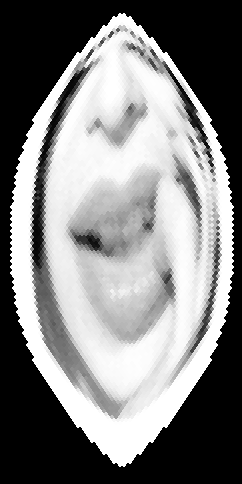Click link to return to Lecture
Schedule
or Lecture Notes by Chapter
Back to Chapter 3 or ahead to
Chapter
5
Case History: Eye in the
Sky
CZCS
animated image source
Make your own
custom
satellite
images from 1978 to 1986 at the
Coastal
Zone Color Scanner website (SeaWiFS)
or
check out Nasa's Image Wall
or Earth
Observatory
I. Sunlight in the Sea
a) The Quality of Underwater Light
terms:
photons, absorption, scattering, light wavelength, infrared,
visible light, ultraviolet, white light, spectrum of solar energy
RQ4.1: Why is the ocean blue?
b) The Quantity of Underwater Light
RQ4.2: Under what conditions can a marine plant live relatively
deep underwater and still photosynthesize?
c) The Effect of Darkness on Life in
the Sea
terms:
euphotic vs. dysphotic vs. aphotic zone
RQ4.3: Explain why most oceanic habitat is fundamentally
less hospitable to organisms than land habitat.
II. The Uses of Light by Marine Organisms
a) The Capture of Solar Energy by Photosynthesizers
terms:
chlorophyll a
1) Marine algae use
pigment molecules to capture light
that chlorophyll misses
terms:
red algal pigments phycoerythrin and phycocyanin,
brown algal pigment fucoxanthin
RQ4.4: Why are land plants and green algae green in color?
2) Does the quality
of light determine the depths at which
algae grow most profusely?
RQ4.5: Why does one find red and brown algae successful
at relatively greater depths than green algae
b) Using light to See and Be Seen
1) Many marine
animals have excellent vision
terms:
fishes and squids have cameralike eyes with
lens and retina, crustaceans (and other arthropods) have
compound eyes with multiple ommatidia, other animals
have simple eyespots or can sense light all over body

 Image
(L) as seen through a bee's
eye (R)
Image
(L) as seen through a bee's
eye (R)
2) Animals use transparency, camouflage, and
countershading as ways of avoiding notice by
predators or prey that use eyesight
terms:
chromatophores, visual predators, countershading
RQ4.6: Many animals use chromatophores for camouflage. Explain
how other animals use light coloration (e.g., fish), or even have light
organs with symbiotic bacteria that "glow in the dark" (see squids
below) to brighten their undersurface (ventral side), while their top
(dorsal) side is dark in coloration?
c) The Production of Light by Organisms
terms:
bioluminescence, luciferase,
luciferin
RQ4.7: If the sun's light doesn't penetrate very deep, explain
how there can still be quite a bit of light in the deep sea.
1) The reasons
for bioluminescence are diverse and not all understood.
It
occurs in diverse, mostly marine, organisms.
More
Links: 1
- 2 - 3
- 4
- 5 - 6
- 7 - 8
- 9
- (10 or 11:
Harbor Branch sites - not responding 2/17/02)
Featured Organisms:
p. 91: dinoflagellates
or here (incl. red
tide)
p. 92: ctenophores (comb jellies)
RQ4.8: The advantage of bioluminescence
sometimes seem
obscure, if there are indeed always advantages, but what are
some alternative hypotheses that might explain why animals
such as the tiny dinoflagellates or walnut-sized ctenophores
appear to make themselves more visible to predators?
2) The lights of some animals confuse predators
3) The lights of some
predators attract or spotlight prey
terms:
photophores
Featured Organisms:
p. 92: flashlight
fish (Photoblepharon
palpebratus)
p. 92: Pachystomias
(loosejaws or black dragonfish)
RQ4.9: Why does the loosejaw fish, Pachystomias, have a
particularly striking adaptative use of light organs for its
success as a deepsea hunter?
4) Ventral lights hide the silhouettes of many midwater animals
Featured Organisms:
p. 92: lantern
fish
p. 93: squids with
photophores for countershading
RQ4.6: See above.
5) Light can be used for species recognition
d) The Use of Light Cycles to Initiate Daily and Seasonal Activities
1) Organisms
that migrate to the sea surface and back each
night often control their movements by tracking sunlight
terms: diurnal
(or diel) migration
Featured Organism p. 94: copepod
(see also RQ 1.14, p. 14, 114, Tab. 5.1)
RQ4.10: Explain how a planktonic
organism such as a copepod
can benefit from diurnal migration.
2) Long nights
change the reproductive activities - and even the
shape - of some algae
terms: photoperiodism
III. Underwater Sound
terms: wavelength,
frequency, hertz, SOFAR
Featured Organism:
Why do narwhals have an 8 foot long tooth? (Click here to find out)
 Image source
Image source
IV. Sound Detection and Production by Marine Animals
a) Incidental Noise - An Unavoidable
Side Effect of Movement
in Water
b) The Detection and Production of Sounds by Fishes
1) The lateral
lines of fishes detect
vibrations and low-
frequency sounds
terms: lateral
line, romasts
RQ4.11: What advantage is there to be able to detect
vibrations or low-frequency sounds as a fish?
2) The inner
"ears" of fishes detect high-frequency sound;
their swim bladders both help with detection and produce
sounds
terms: otoliths
c) Sound as a Weapon of Offense and Defense
The beluga whale
has an especially pronounced melon.
See one at Chicago's
Shedd Aquarium in Jessica Ruck's
Beluga
QuickTime movie
1) Most toothed
whales use echolocation
terms: toothed
vs. baleen whales
RQ4.12: Where and how do toothed whales (including
dolphins) generate sounds for echolocation? What are
these sounds used for?
2) Echolocation is a sensitive way of seeing the world
e) Sound as a means of Communication
1) Dolphin whistles don't seem to resemble human language
Apple Computer
has some cool online Quicktime videos on
studies
of dolphin intelligence or here
RQ4.13: What evidence is there that dolphin clicks might
or might not be analogous to our use of language?
2) Humpback
whales "sing" complex "songs" during mating
season
RQ4.14: Which humpbacks sing and when do they sing? Are
there regional differences in the song sung?
3) Do whales
"talk" over long distances?
RQ4.15: What is the evidence that whales may be able to
communicate over great distances?
Listen
to a sperm whale song here
Click link to return to Lecture
Schedule
or Lecture Notes by Chapter
Back to Chapter 3 or ahead to
Chapter
5
This Page Created 2/11/01 © D.J. Eernisse, Last Modified 12/29/05, Links
Last Completely Checked 2/17/02